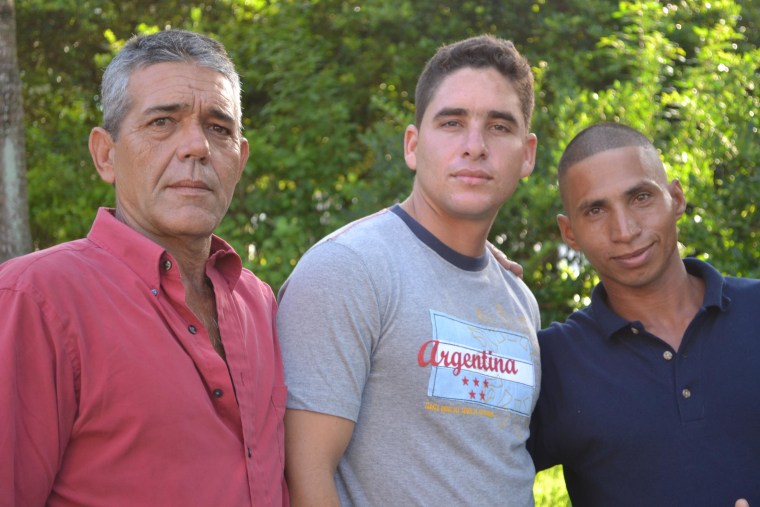MIAMI, FL -- A group of 9 Cubans made recent local headlines when the small, homemade boat they sailed in from Cuba landed in front of a swanky oceanfront condominium in South Florida while people shouted “welcome to the land of freedom,” from their windows above.
A few days after their 10 day ordeal through the treacherous Florida straits, Jose Ramon Fuente Lastre, 23, recounted how anxious he was to leave the Communist island. Although he studied veterinary medicine, he was making a living selling bread, corn, onion and other products on the streets of Camaguey province. “I earned more money this way than working as a veterinarian with the government,” Lastre said. “It’s every young person’s dream to leave the island,” he added.
The group of men is part of a growing number of Cubans arriving to the US in homemade boats or crossing the US-Mexico border, despite economic reforms taking place on the island. Since Raul Castro took over in 2008, he has implemented numerous free-market measures, including turning state owned agriculture over to cooperatives and allowing self-employed contractors to operate small businesses.
The 23-year-old man who made the treacherous journey said he was making more money selling onions and bread than being a veterinarian, and his 50-year-old father said he was tired of waiting for more reforms; "since I was born I've been hearing the same thing."
But experts agree the reforms are taking place at a very slow pace and the spike in Cuban arrivals is a reflection of it. The amount of migrants stopped at sea and arriving at shore is at a 5-year high. At least 3,665 migrants have been stopped at sea or made it to shore this fiscal year according to the US Coast Guard, which is up from 2,129 the previous year, according to the U.S. Coast Guard.
The Coast Guard stressed they do not know how many die at sea. The number of Cubans arriving at the U.S.-Mexico border is much higher. Around 22,755 Cubans had arrived at the U.S.-Mexico border up until August, compared to 18,283 during fiscal year 2013, according to Customs and Border Patrol. According to DHS statistics, this is the highest number of Cuban migrants in the past decade.
“They (the Cuban government) are headed in the right direction but they’re far short of offering alternatives,” according to Peter Hakim, President Emeritus and senior fellow at the Inter-American Dialogue. He said there is a lot of reporting on the successes of businesses, but little about the ones that have had to close or have been subjected to new regulations. He said recent arrivals tend to be young. “If you ask them what they aspire to, the answer generally is, leave Cuba,” Hakim said.
Lastres’ father, Antonio Cardenas Viejo, was also on the boat. While in Cuba, he was approached by several men who had begun to build the craft but had run out of money. Viejo sold two lambs and used the money to purchase a tractor and use the engine for the boat. He was in charge of collecting food and distributing it equally during the trip. “I was the chef. I cooked 3 pork legs and stored them in a bucket full of lard, to preserve the meat during the trip,” Viejo recounted. When asked why he didn’t wait for more reforms to take place on the island before embarking on the perilous trip, he replied “For what? I’m 50 years old and since I was born I’ve been hearing the same thing.”
Yennier Martinez Diaz, 31, another of the migrants, echoed the same feeling. “I couldn’t even buy myself a pair of shoes with the money I was earning,” he said. All three were determined to embark on the trip despite not having relatives or close friends in the US.
“There’s a lost generation in Cuba. People in their 20s really don’t have any hope … People have gotten tired of hearing they have to make sacrifices and eventually things will get better,” said Florida International University professor Jorge Duany, who has been studying Caribbean migration patterns since the 1980s.
Duany added that economic motivations are not the only reason people are fleeing the island – there are social and political reasons as well. He pointed out that in Cuba, the economy is dictated by politics.
The group of men was lucky to arrive safely on the shores of Miami. In August, 32 migrants set sail from Manzanillo in Eastern Cuba and only 15 survived after 3 weeks adrift without food or water. The survivors were intercepted by the Mexican Navy near the Yucatan peninsula, badly sunburned and dehydrated. The Mexican government usually repatriates Cuban migrants but a Mexican immigration official said last week the Cuban government had not recognized the survivors as citizens so they were set free. Some of them headed to the U.S. by bus where they are usually granted asylum.
Under the “wet foot dry foot policy” Cubans who make it onto US soil are allowed to remain, while those intercepted at sea are returned to the island.
The US Coast Guard recently announced they repatriated 53 Cuban migrants who were intercepted during the previous weeks on 3 separate incidents. One group of 15 migrants was found near Houma, Louisiana, another boat with 29 migrants was found near Key West, and the third group with 9 Cubans was intercepted south of Mobile, Alabama.
Before leaving Cuba, the men were hearing a lot of chatter about others building rafts and heading to the US. They’re afraid there will be a “fury” of rafters leaving the island, acknowledging the trip was tougher than they had imagined.
Viejo mentioned he saw homeless people on the streets on Miami asking for money. “I would never do that. I came here to work. All I want to do is work and make money,” he said.
